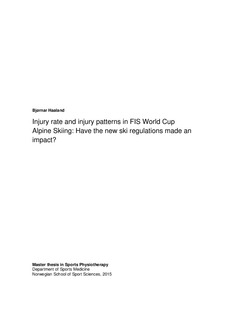Injury rate and injury patterns in FIS World Cup Alpine Skiing: have the new ski regulations made an impact?
Master thesis
Permanent lenke
http://hdl.handle.net/11250/2354022Utgivelsesdato
2015-10-12Metadata
Vis full innførselSamlinger
Sammendrag
Background: New regulations for ski equipment were implemented prior to the 2012/2013
season in the International Ski Federation (FIS) alpine World Cup (WC). Objective: This is
the first study to investigate the effect of the new ski regulations on the rate, pattern and
mechanisms of injury by comparing data before (2006-12) and after (2012-14) the
implementation. Methods: Injuries were recorded by the FIS Injury Surveillance System
(FIS ISS) through retrospective interviews at the end of eight WC seasons (2006-14). All
acute injuries occurring in the competitive season that required medical attention were
registered. Injury incidence was expressed as the absolute injury rate (injuries/100
athletes/season) and as the relative injury rate (injuries/1000 runs). Exposure was calculated
by using official results listed on the FIS webpage. Videos of nine ACL injuries reported
through the FIS ISS were systematically analysed in order to describe the injury mechanisms.
Results: There was a higher rate of injury in training and competitions before risk ratio (RR)
1.47 (95% CI 1.22 to 1.77) compared to after the new ski regulations, expressed as
injuries/100 athletes/season. The relative injury rate (per 1000 runs) during WC races was
also found to be higher in the seasons before RR 1.60 (95% CI 1.20 to 2.15) the new
regulations. No difference was found in the rate of knee/ACL injuries or in the injury
mechanisms. Conclusion: There was 1.5 times higher risk of injuries in the seasons before
the new regulations of ski equipment. The changes done to the equipment therefore seems to
be successful.
Beskrivelse
Masteroppgave - Norges idrettshøgskole, 2015
